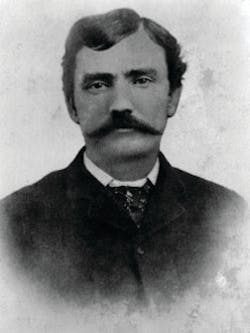It seems that a reoccurring trend in the Old West (mid- late 1800’s) is that lawmen are often described as being criminals by some and heroes by others. Another trend seen is that lawmen in those days were extremely proficient with their iron… without mandatory annual range qualification. This month’s legendary lawman is no exception. I give you John King Fisher (yes, his real name).
There are those who claim that the most effective lawmen were once criminals and John King Fisher surely fit this description. He was born 1854 to Jobe Fisher and Lucinda Warren in Collin County, Texas (northeast of Dallas). Just prior to the Civil War the family relocated to Florence, Texas (north of Austin). Fisher grew to 5’ 9” and a svelte 135 pounds. The 1870s in Texas was particularly lawless mostly as a result of the end of the Civil War and thousands of armed and unemployed soldiers wandering the west. This is where a young (very young) John King Fisher would learn the ropes of survival.
In 1869 he was accused of stealing a horse after he borrowed it without bothering to inform the horse’s owner (hey, it happens) to track down his own ride that had wandered off in the night. He was tracked down by a posse and arrested but reportedly escaped with the help of the horse's owner, Mr. Turnbow. After returning home to Goliad, Texas he once again ran afoul the law when he was, according to a family story, arrested for housebreaking. Apparently he had hooked up with a bad crowd and led astray. He was sentenced on 5 October 1870 to two years in the state penitentiary but was released in February of 1871 due to good behavior and his age. He was under sixteen at the time of his sentencing.
After his release he moved to Dimmit County and established his own ranch on the Pendencia Creek, located near Eagle Pass on the border of Mexico. Not one for subtlety, on the road that lead to his ranch he posted a sign reading "THIS IS KING FISHER'S ROAD. TAKE THE OTHER ONE." Evidently somewhat of a wit, he once said, "Fair play is a jewel, but I don't care for jewelry." This area was Nueces Strip and commonly known as an area where cattle rustling was the number one industry. King Fisher hired on every drifter, rustler and criminal in the area and quickly became the leader of the Strip. At one time Fisher rode with Mexican rustlers and is claimed to have killed as many as 10 gang members before emerging as their leader. Some say that King Fisher traded cattle with the eventual president of Mexico, Porfirio Diaz (another colorful figure) taking stolen Mexican in trade for Texas cattle.
During the 1870s Fisher also took a liking to gambling and was reportedly pretty good at it. Of course he was quick to anger and even quicker on the draw which resulted in more than a few shootings. In 1878 he claimed to have killed seven men, mostly in gambling arguments, and he was not including "several Mexicans.”
One persistent account concerns an argument between King and four vaqueros that had approached his cattle pen on the Pendencia Creek. King Fisher assumed these men were there to rustle his cattle and “asked” them to leave. When they refused he struck the nearest opponent on the skull with a branding iron, outdrew, shot and killed a second man, who had drawn his revolver, with a single shot through the head, then whirled and drilled the other two men as they, too, were drawing their pistols, killing both. The last two were still sitting on the fence. Although these four killings were never verified, tall tales about King Fisher abounded throughout Texas during his lifetime and continue to this day.
Apparently Fisher was not the best choice for a drinking buddy either. On Dec. 25, 1876 in a bar in Zavala County, Texas, a cowboy named William Donovan refused to buy Fisher a drink, so he fired three bullets into Donovan, killing him. Fisher was subsequently arrested by Texas Ranger Lee Hall who charged him with murder. Fisher however, was expertly defended in court by Major T.T. Teel and was found not guilty. Of course we don’t have all the facts here but we clearly see a history of a quick temper followed by dead bodies.
In 1876 King Fisher married Sarah Vivian and eventually had four daughters. Having a family apparently had a calming effect on the man as he began to settle down and his unfavorable accounts seem to have stopped. (Except when he shot himself in the leg in 1879, accidently.) By 1881 he had been cleared of all charges and accepted the position of Deputy Sheriff of Uvalde County, Texas. He was appointed interim Sheriff (the previous Sheriff was being indicted) until he ran for the position in 1884.
One interesting side story is the apprehension of Jim Hannehan. Two brothers, Jim and Tom Hannehan were accused of robbing a stagecoach. Sheriff Fisher trailed the men to their ranch near Leaky, Texas and when he encountered them they resisted. Tom was shot and killed but Jim surrendered and returned the loot. Following King’s death, the Hannehan’s mother was known to come to King’s grave each year on the anniversary of Tom’s death to build a fire and dance on King’s grave. Nice.
Overall, John King Fisher was regarded as a popular and extremely effective lawman. Unfortunately his choice of companionship was to be his undoing. While attending the Vaudeville Variety Theater (Austin, Texas) on March 11, 1884 with noted gunslinger Ben Thompson they were ambushed while watching the show. Apparently this was the wrong opera house to attend with Mr. Thompson as he had shot and killed the owner of the establishment just two weeks prior. Sitting in the box with Thomson and Fisher were Joe Foster and Billy Simms, former partners of the deceased Jack Harris. Fisher attempted to leave "before trouble started” but the two men were shot down.
Accounts of the day say that Foster and Simms were assisted by three men lurking in the shadows. These men aimed rifles and shotguns into the box and Fisher was struck thirteen times in the head and chest. As is the norm for the period, there are conflicting accounts of the events that evening. There was a public out cry for a grand jury indictment of those involved. No action was ever taken. The San Antonio Police and the prosecutor showed little interest in the case and it was ruled a case of “self-defense”.
John King Fisher was buried on his ranch on the Pendencia Creek, he was thirty years old. In the 1930s, his body was moved from its original burial site and buried in the Pioneer Park Cemetery in Uvalde, Texas.
About The Author:
Charles Bennett was born in our Nation's Capital and grew up in the Maryland suburbs. Mr. Bennett has been working in all aspects of the publishing industry since the late 1980s primarily in the fields of commercial photography and magazine production. Moving to California in 1992 to attend college resulted in B.F.A and Masters degrees. California also supplied Mr. Bennett with his wife. The two of them are avid sports persons and participate in shooting, scuba diving, surfing, running and bicycling. As a long time hobby Mr. Bennett has studied the legends of American law enforcement which led to his writing these columns.
About the Author
Charles Bennett
Charles Bennett was born in our Nation's Capital and grew up in the Maryland suburbs. Mr. Bennett has been working in all aspects of the publishing industry since the late 1980s primarily in the fields of commercial photography and magazine production. Moving to California in 1992 to attend college resulted in B.F.A and Masters degrees. California also supplied Mr. Bennett with his wife. The two of them are avid sports persons and participate in shooting, scuba diving, surfing, running and bicycling. As a long time hobby Mr. Bennett has studied the legends of American law enforcement which led to his writing these columns.

